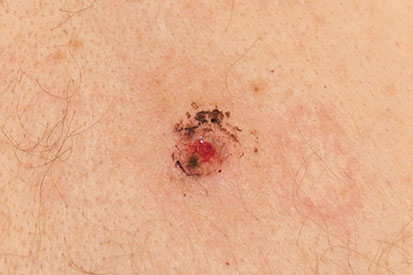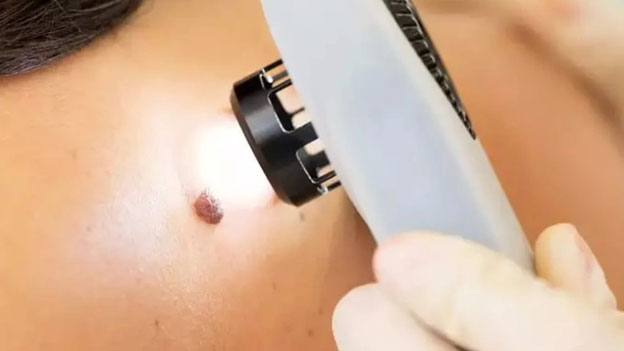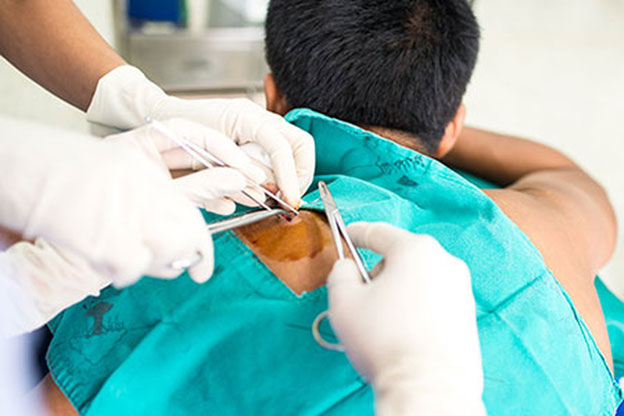Dr Guillaume Orieux, Head of the Dermatology Department of FV Hospital, says that skin cancer is a malignant disease that can be can be deadly when detected late. Dr Orieux has 35 years of experience in this field and has worked at dermatology clinics and hospitals in France, the UK and Vietnam. Now, he leverages his international expertise to care for FVH patients.
A doctor who has been passionate about skin research since childhood
Dr Orieux has loved biology since he was young. He was brought up in a family where his grandfather was a natural science professor and his father a doctor, so Guillaume had access to medical journals from a young age. “Back then, articles about skin diseases were especially appealing to me. I have been interested in and immersed in this specialty ever since,” he explains.

Dr Guillaume Orieux, Head of the Dermatology Department, FV Hospital
While attending medical school, Dr Orieux had the opportunity to study different specialties. However, dermatology remained his passion and after completing an internship at a military hospital, he decided to pursue a career in dermatology. Today, Dr Orieux is renowned as one of the world’s foremost experts in treating difficult dermatology cases.
Dr Orieux has worked as a senior consultant in dermatology for various hospitals in France, and has worked as a visiting doctor in the UK and Vietnam since 2002. During his visits to Vietnam, Dr Orieux fell in love with the country’s people, landscapes and culture and moved here in 2008.
During his time at FV, Dr Orieux has treated more than 300 different skin diseases for tens of thousands of patients in Vietnam, including common diseases such as scabies, psoriasis, bullous disease, sexually transmitted diseases, and skin cancer—one of the most dangerous.
Unfortunately, there is little awareness of skin cancer in Vietnam, and people here often don’t understand the importance of prevention and screening so that cancerous cells can be detected early.
Skin cancer: a dangerous disease with easy-to-ignore signs
What you need to know about skin cancer
There are many types of skin cancer. The most common types are basal cell carcinoma, squamous cell carcinoma, and melanoma.
Basal cell carcinoma (BCC) is the most common type, accounting for 80 per cent of skin cancers. BCC is characterised by malignant keratinocytes growing on the skin and most often appears in fair-skinned people, especially those aged over 50 years old. On fair skin, BCC typically appears as slightly transparent bumps, pearl-like bumps, or a pink patch on the skin. On Asian skin, BCC presents as a dark blotch. The disease develops after years of frequent sun exposure or tanning. In cases of late identification, BCC can spread to nerves and bones.

Unusual changes in the skin can be a sign of skin cancer, yet these signs are easy to ignore
The second most common type is squamous cell carcinoma (SCC), which accounts for about 20 per cent of skin cancers. SCC is also a malignant keratinocyte proliferation on the skin. People with fair skin are at a higher risk than with those with darker skin. The disease is mainly found in people aged over 45 years old. SCC symptoms may start as small, red, flat spots but grow larger and become scaly or thick, or ulcers that heal and then recur. SCC can grow deep into the skin, spread to other areas of the body, metastasise and cause damage.
Cutaneous melanoma (CM) is a malignant growth of pigment cells in the skin and is the most serious type of skin cancer as it tends to spread. Although this type accounts for just one per cent of skin cancer cases, CM causes 82 per cent of skin cancer deaths. The one-year chance of survival after diagnosis is 100 per cent for melanoma in situ but only 12 per cent if the cancer has already metastasised in the body.
Dr Orieux, FV’s Head of Dermatology, says CM can develop from a mole that is already on the skin or appear suddenly as a dark spot on the skin. It can also create a new pigment line on the nail. CM is indicated by signs such as asymmetrical ulcerated spots or moles; irregular-shaped, uneven or lop-sided moles; moles and spots that vary in colour; and spots that grow or change in size, shape and colour.

The doctor checks suspicious areas of skin with a dermatoscope
Because the signs are easily ignored and cause little pain or discomfort, skin cancer is often overlooked by patients. To clinically diagnose skin cancer, the doctor examines the patient for lesions with a dermatoscope, which allows them to discover structures not visible to the naked eye. For skin cancers with a small surface area, excisional surgery can be performed the same day by a dermatologist.
In the case of large skin cancers or cancers in hard-to-reach locations, a dermatologist will take a biopsy sample for the lab to analyse before referring the case to a surgeon.
Depending on the location of the tumour, the surgeon that performs the surgery may be a plastic, ENT, maxillofacial or orthopaedic specialist, or a general surgery doctor.
“In addition to surgery, in cases of advanced skin cancer, patients may need radiation therapy, chemotherapy, or immunotherapy,” explains Dr Orieux. “New therapies applied to advanced melanoma, such as immunotherapy and targeted therapy, can significantly increase the chances of survival and cure.”
Never overlook symptoms of skin cancer

Skin cancer surgery at FV Hospital
In Western countries, skin cancer awareness has drastically increased over the past decade and people now readily consult a doctor when they notice a strange spot on their skin.
In Vietnam, skin cancer is less common and many people do not think dark spots or melasma on the skin are cause for concern. Instead, people may seek cosmetic treatments to remove marks without realising they are a sign of danger. Compounding the problem, few doctors in Vietnam have the awareness and skill to diagnose skin cancer in its early stages.
In one case, when a patient visited the Dermatology Department with signs of skin cancer, their doctor requested a biopsy so that cancer could be confirmed, but the patient ignored the recommendation. It was not until a year later, when the skin cancer cells had grown into a large tumour, that the patient returned to see the doctor. MRI results showed that the tumour had metastasised, making treatment much more difficult.
“The perception that skin cancer is not dangerous is not true. A tumour on the skin may only measure five millimetres in size, but can be very dangerous when the patient is not treated, or treatment is not appropriate,” says Dr Orieux.
“According to statistics, 50 percent of patients who fit this profile will die within five years. I cannot emphasise enough that skin cancer is equally as dangerous as any other type of cancer.”
Dr Orieux says that people with high risk factors, such as having fair skin, multiple melanomas on the skin, a family history of skin cancer or personal history of having skin cancer, should have regular check-ups with a dermatologist.
After working in Vietnam for many years, Dr Orieux understands that to raise awareness of skin cancer, it is necessary to improve communications to the community to increase everyone’s ability to detect signs of skin cancer.
Most skin cancers are caused by exposure to ultraviolet radiation. People should limit sun exposure or avoid tanning, especially people with fair skin, and avoid sunburn, especially during childhood. Dr Orieux also recommends that everyone should regularly use a broad-spectrum, water-resistant sunscreen of at least SPF 30+. Individuals with high risk factors should use SPF 50+.
For a skin health check-up, please make an appointment by calling (028) 54 11 33 33.



